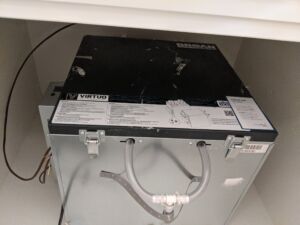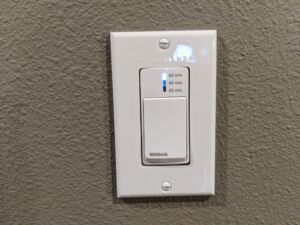
The basic principle of HRV involves exchanging stale indoor air with fresh outdoor air while simultaneously recovering the heat from the outgoing air. Here’s how it generally works:
Exhaust Ventilation:
Stale indoor air is extracted from areas like kitchens, bathrooms, and utility rooms, where moisture and pollutants are typically higher.
Heat Exchange:
The extracted air passes through a heat exchanger, which transfers the heat from the outgoing air to a heat transfer medium.
Fresh Air Intake:
Meanwhile, fresh outdoor air is drawn into the system and also passes through the heat exchanger. The heat from the transfer medium warms the incoming air.
Supply Ventilation:
The now pre-warmed fresh air is then distributed throughout the building, providing ventilation without the loss of much heat.
Energy Recovery Ventilation (ERV) is a ventilation system that, like Heat Recovery Ventilation (HRV), is designed to improve indoor air quality while also optimizing energy efficiency in buildings. Both ERV and HRV systems share the basic principle of exchanging stale indoor air with fresh outdoor air, but they differ in their approach to handling not only heat but also moisture.
Here are the key differences between ERV and HRV:
Moisture Transfer:
ERV: In addition to heat transfer, ERV systems actively transfer moisture, which can be useful in preventing excessive indoor humidity during hot and humid seasons or adding moisture to dry indoor air during cold seasons.
Applicability:
HRV: Well-suited for climates where temperature variations are more significant than humidity variations. It is commonly used in cold climates.
ERV: Particularly beneficial in climates with both extreme temperature and humidity variations. ERV systems are suitable for both cold and hot climates.
Air Quality:
HRV and ERV: Both systems contribute to maintaining a continuous supply of fresh air, helping to improve indoor air quality by reducing pollutants, odors, and stale air.

Heat Recovery Ventilation (HRV) and Energy Recovery Ventilation (ERV) systems can indirectly contribute to extending the life of the installed HVAC (Heating, Ventilation, and Air Conditioning) system in a building. While HRV and ERV systems themselves do not directly impact the lifespan of HVAC components, their role in maintaining indoor air quality and reducing the load on the HVAC system can have positive effects.
HRV and ERV systems help maintain indoor air quality by continuously supplying fresh air while simultaneously exhausting stale air. This can reduce the reliance on the HVAC system for ventilation purposes, especially in buildings with airtight construction. By providing a separate source of fresh air, HRV systems can lessen the load on the HVAC system, potentially reducing wear and tear on components.
Proper ventilation, including the use of HRV and ERV systems, helps control humidity levels within a building. Maintaining balanced humidity is essential for the optimal functioning of HVAC systems, as excessive moisture can lead to issues such as mold growth and increased strain on cooling components.
HRV and ERV systems recover heat from the outgoing air, helping to pre-heat the incoming fresh air during colder months. This energy recovery process can result in overall energy savings, and when the HVAC system operates more efficiently, it may experience less wear and tear.
While HRV systems offer these benefits, it’s essential to note that they are not a substitute for proper HVAC maintenance. Regular maintenance and servicing of the HVAC system, including cleaning filters, checking refrigerant levels, and inspecting components, remain crucial for ensuring the longevity and optimal performance of the HVAC equipment.
Maintaining HRV and ERV systems is crucial to ensure their optimal performance and longevity. It is important to have these systems serviced annually along with your HVAC equipment by a qualified HVAC professional. In addition to annual servicing, you should ensure that the filter is clean and replaced regularly.
The expected serviceable life of HRV and ERV systems can vary depending on factors such as:
Quality of Installation: Proper installation by qualified professionals is crucial for the system’s longevity.
Brand and Model: The quality of the equipment and the reputation of the manufacturer can influence the lifespan.
Maintenance: Regular and proper maintenance can significantly extend the serviceable life of HRV and ERV systems.
Generally, HRV and ERV systems are designed to last around 15 to 20 years or more with proper care and maintenance. However, individual experiences may vary, and it’s essential to refer to the manufacturer’s guidelines for specific recommendations.
Regularly following the maintenance tasks outlined above and scheduling professional inspections can help homeowners maximize the lifespan and efficiency of their HRV and ERV systems. Always consult the manufacturer’s documentation for specific maintenance requirements and guidelines.
